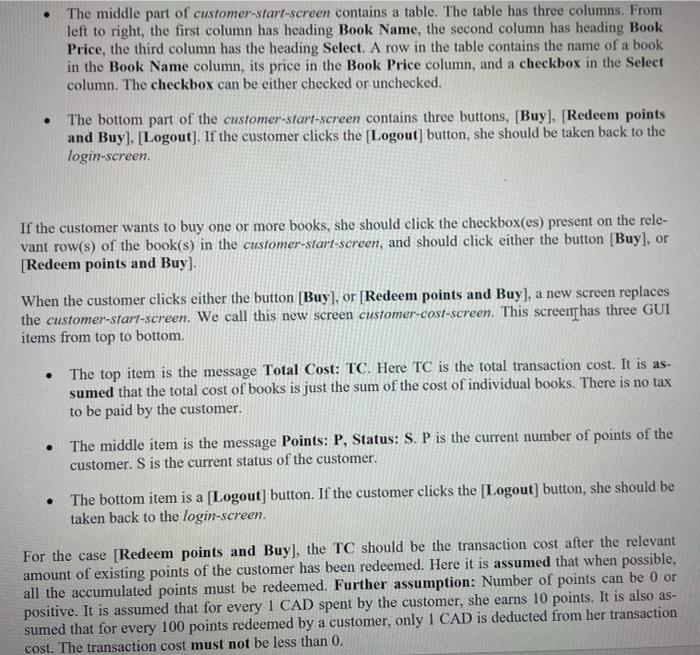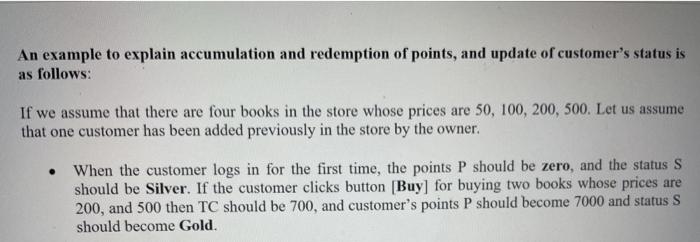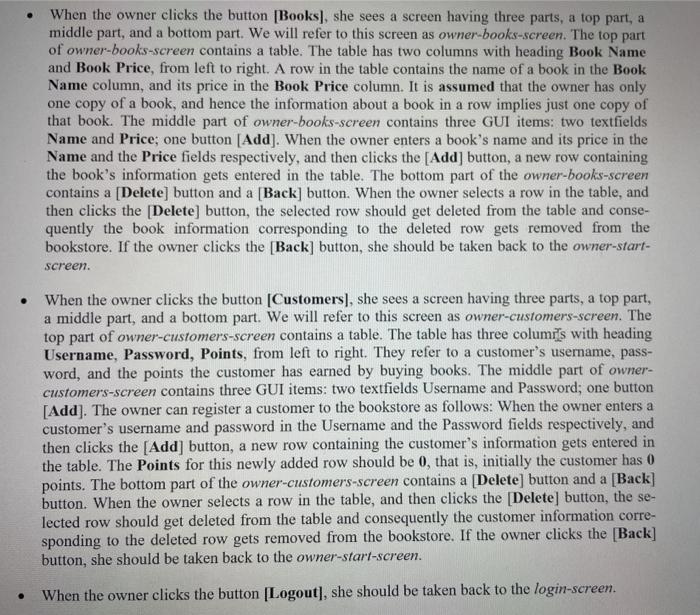Analyze , design and implement a bookstore application.
Please use netbeans Java (8.2)
Design with UML diagrams (Use case diagram and class diagrams).Use visual Paradigm to draw UML.
Use state design pattern in software design
Implement the system
The GUI of the application has to be developed using Java FX. JavaFX scene Builder may be used , if necrssary.
The tables can be created using the class TableView.
please see below the problem.
Problem Description:
HOW THE OWNER WILL USE The Bookstore app:
How a registered customer will use the BookStore app:




Problem Description You will develop a simple Book Store Application (app). The app must be graphical user interface (GUI) based. The app should be a single-window GUI, that is, ONLY one window should be available to the user of the app (analogous to a web browser). This implies that if a user of the app clicks a button to obtain a new screen, the last screen of the app should be replaced by the new screen, in the SAME window (i.e. multiple windows MUST NOT get opened while using the app). Whenever a user of the app clicks the [x] button (i.e. the exit button) at the top-right of the app win- dow, all the relevant data currently present in the app should be written in two relevant files books.txt and customers.txt Page 1 of 6 To keep the implementation simple, it is suggested that every time the [x] button is clicked, the old data in books.txt and customers.txt should be overwritten by the current data present in the relevant data structure(s) of the app. It is also suggested that every time the app is started, the data from the two files books.txt and customers.txt should be loaded in the data structure(s) of the app. There are two kinds of users of this application: Owner and Customer. Here we will assume there is only one Owner and zero or more Customers who uses the application. The app starts with a login-screen. The login-screen has three GUI items: a username field, a password field, and the button (login). The owner's username is admin and password is admin A sample login screen is: 1 Bookstore App Welcome to the BookStore App Username: Password: Login How the owner will use the BookStore app: When the owner enters her username and password, and clicks button [login], a new screen replaces the login-screen. We call this new screen owner-start-screen. The owner-start-screen has three buttons: [Books] [Customers). [Logout). A sample owner-start-screen is: Bookstore App [x] Books Customers Logout . When the owner clicks the button [Books), she sees a screen having three parts, a top part, a middle part, and a bottom part. We will refer to this screen as owner-books-screen. The top part of owner-books-screen contains a table. The table has two columns with heading Book Name and Book Price, from left to right. A row in the table contains the name of a book in the Book Name column, and its price in the Book Price column. It is assumed that the owner has only one copy of a book, and hence the information about a book in a row implies just one copy of that book. The middle part of owner-books-screen contains three GUI items: two textfields Name and Price; one button [Add). When the owner enters a book's name and its price in the Name and the Price fields respectively, and then clicks the [Add] button, a new row containing the book's information gets entered in the table. The bottom part of the owner-books-screen contains a [Delete] button and a [Back] button. When the owner selects a row in the table, and then clicks the [Delete] button, the selected row should get deleted from the table and conse- quently the book information corresponding to the deleted row gets removed from the bookstore. If the owner clicks the [Back] button, she should be taken back to the owner-start- screen. When the owner click the button [Customers), she sees a screen having three parts, a top part, a middle part, and a bottom part. We will refer to this screen as owner-customers-screen. The top part of owner-customers-screen contains a table. The table has three columr's with heading Username, Password, Points, from left to right. They refer to a customer's username, pass- word, and the points the customer has earned by buying books. The middle part of owner- customers-screen contains three GUI items: two textfields Username and Password; one button [Add). The owner can register a customer to the bookstore as follows: When the owner enters a customer's username and password in the Username and the Password fields respectively, and then clicks the [Add] button, a new row containing the customer's information gets entered in the table. The Points for this newly added row should be 0, that is, initially the customer has 0 points. The bottom part of the owner-customers-screen contains a [Delete] button and a [Back] button. When the owner selects a row in the table, and then clicks the [Delete] button, the se- lected row should get deleted from the table and consequently the customer information corre- sponding to the deleted row gets removed from the bookstore. If the owner clicks the [Back] button, she should be taken back to the owner-start-screen. . When the owner click the button (Logout), she should be taken back to the login-screen. How a registered customer will use the BookStore app: When a customer, say Jane (previously added by the owner) enters her username and password, and clicks button (login), a new screen replaces the login-screen. We call this new screen customer-start- screen. The customer-start-screen has three parts, a top part, middle part, and a bottom part. . The top part shows the message "Welcome Jane. You have P points. Your status is S". Here, P is the number of points Jane currently has. S is one of the two status, either Gold or Silver, that Jane has. A customer who has points less than 1000 has status silver. A customer who has points 1000 or above has status gold. The middle part of customer-start-screen contains a table. The table has three columns. From left to right, the first column has heading Book Name, the second column has heading Book Price, the third column has the heading Select. A row in the table contains the name of a book in the Book Name column, its price in the Book Price column, and a checkbox in the Select column. The checkbox can be either checked or unchecked. The bottom part of the customer-start-screen contains three buttons, [Buy], [Redeem points and Buy], [Logout). If the customer clicks the [Logout) button, she should be taken back to the login-screen If the customer wants to buy one or more books, she should click the checkbox(es) present on the rele- vant row(s) of the book(s) in the customer-start-screen, and should click either the button (Buy), or [Redeem points and Buy]. When the customer clicks either the button [Buy), or [Redeem points and Buy), a new screen replaces the customer-start-screen. We call this new screen customer-cost-screen. This screenshas three GUI items from top to bottom. The top item is the message Total Cost: TC. Here TC is the total transaction cost. It is as- sumed that the total cost of books is just the sum of the cost of individual books. There is no tax to be paid by the customer. The middle item is the message Points: P, Status: S. P is the current number of points of the customer. S is the current status of the customer. . The bottom item is a [Logoutbutton. If the customer clicks the [Logout] button, she should be taken back to the login-screen. For the case [Redeem points and Buy), the TC should be the transaction cost after the relevant amount of existing points of the customer has been redeemed. Here it is assumed that when possible, all the accumulated points must be redeemed. Further assumption: Number of points can be 0 or positive. It is assumed that for every I CAD spent by the customer, she earns 10 points. It is also as- sumed that for every 100 points redeemed by a customer, only 1 CAD is deducted from her transaction cost. The transaction cost must not be less than 0. An example to explain accumulation and redemption of points, and update of customer's status is as follows: If we assume that there are four books in the store whose prices are 50, 100, 200, 500. Let us assume that one customer has been added previously in the store by the owner. When the customer logs in for the first time, the points P should be zero, and the status S should be Silver. If the customer clicks button (Buy) for buying two books whose prices are 200, and 500 then TC should be 700, and customer's points P should become 7000 and status S should become Gold. In the next login session, if the same customer clicks [Redeem points and Buy] for buying the book with price 50, then TC should be 0, and customer's points P should become 2000. Cus- tomer's status S stays at Gold. In the next login session, if the same customer again clicks [Redeem points and Buy] to buy the book with price 100, then TC should be 80, and customer's points P should become 800. The customer's status should change to Silver















